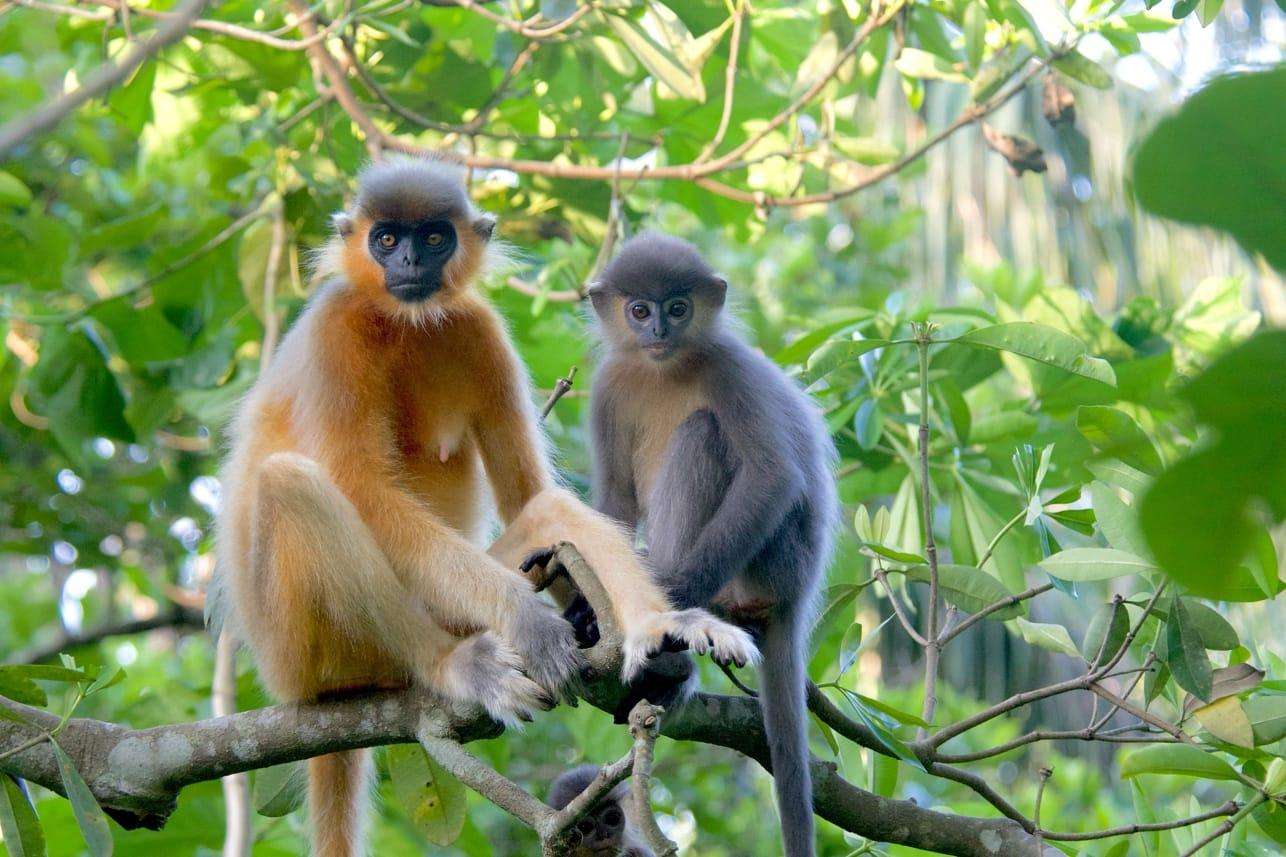"Conservation of forests must become a national priority. If we do not take action now to protect the habitats, we will not only lose two species of Hanuman, we will also lose a part of Bangladesh's priceless biodiversity." - Tanveer Ahmed
"The results of this study are a warning, this is just the beginning" - Dr. Dittmar Giner
Mixed species groups and hybrids of globally endangered Spectacled Hanuman and Mukhpora Hanuman have been identified in forest areas of Sylhet Division.
Recently, a research paper regarding this has been published in Springer Nature's International Journal of Primatology. The research, which lasted for about 6 years, was led by Tanveer Ahmed, a Bangladeshi PhD student at the world-renowned German Primate Center and a member of the IUCN primate expert team.In addition to the researchers of the German Primate Center, this research team of 15 members includes the professor of the United Arab Emirates University. Sabir bin Muzaffar, Md Sabit Hasan, Principal Researcher of Isabella Foundation, some students of Jagannath University, local eco-guides and wildlife photographers.
With the permission of Bangladesh Forest Department, field level research activities were conducted from 2018 to October 2023. Then, the genetic testing of Hanuman's feces goes to the laboratory to confirm the hybrid.
Spectacled Hanuman is globally endangered and Critically Endangered in Bangladesh in IUCN Red List. Their range is only from Bangladesh through India to the Irrawaddy River in Myanmar. Mukhpora Hanuman is globally endangered and is listed as endangered in Bangladesh.
Apart from Bangladesh, Mukhpora Hanuman is found in India, Bhutan, Myanmar and small parts of China. These two species of Hanuman live in several hilly forests of Sylhet and Chittagong divisions of Bangladesh.
Besides, there is Hanuman with burnt face in Patrajhra forest of Madhupur. However, there is no clear information about how many Hanumans of these two species have survived in Bangladesh as well as in the world. A group of bespectacled Hanumans usually consists of 4 to 26 Hanumans and a group of half-faced Hanumans usually consists of 4 to 17 Hanumans.
Both are primarily herbivores and burrow into the ground when necessary. Wild foliage, flowers and fruits, insects are their main food. They play an important role in feeding and dispersing the seeds of various fruits to different parts of the forest, which naturally gives new life to the forest.
According to research sources, in 1997-98 Rema-Kalenga Forest, Professor of Zoology Department of Jahangirnagar University. Mofizul Kabir first observed two temporary mixed-species groups, the bespectacled Hanuman and the bespectacled Hanuman, during his PhD research. No hybrids were present in them either.Almost 20 years later, in 2017 we were surprised to see a possible hybrid Hanuman in Satchari National Park for the first time. Earlier, there is no scientific history of these two species of Hanuman giving birth to a hybrid Hanuman.
A hybrid Hanuman in Satchari National Park whose mother is face-faced Hanuman and father is bespectacled Hanuman. Photo: Mahmudul Bari
Mixed-species Hanuman grouping and hybridization As the first phase of field-level research, the researchers surveyed Hanuman for a total of 92 days in Lauachhara, Satchari, Rema-Kalenga, Rajkandi, Patharia and Atora reserve forests of Sylhet division. Hanuman groups of mixed breeds are kept under regular observation for about 4 years.
A total of 98 Hanumans were found in the survey, of which 41 were bespectacled Hanumans, 49 bespectacled Hanumans and the remaining 8 mixed-race Hanumans. The researchers also identified three possible hybrid Hanumans based on physical characteristics in three mixed groups.Two of which are found in Satchari National Park and one in Rema-Kalenga Wildlife Sanctuary. Among the possible hybrids, the first Hanuman was a full-grown female, whose breast size and elongated teat pattern suggest that she had also had a child and that the child was regularly milked. The other two possible hybrid Hanuman minors. However, the only way to confirm hybridization is to perform genetic testing of potential hybrids. To confirm hybridization, faecal samples collected from Satchari National Park were subjected to genetic testing at the laboratory of the German Primate Center in Germany.
In this research, a groundbreaking information emerged - the possible hybrid Hanuman born in 2023 in a mixed group of Satchari is actually the father of the bespectacled Hanuman and the mother of the masked Hanuman.
The presence of hybrid Hanumans is particularly worrisome, as it indicates that genetic drift between these two endangered species may have irreversible effects on their future genetic makeup. Hybridization is a rare but natural phenomenon, usually occurring at the junction of two species' ranges. This type of hybridization has been observed in many species of animals.
Hybridization is a very important topic of evolutionary process and classification of animals.However, human-caused activities such as deforestation, fragmentation of large forests, depletion of wild populations due to illegal hunting and trade, and the release of invasive species are increasing the risk of monkey-Hanuman hybridization.
In recent times this trend is increasingly being documented in most of the Hanuman species of the Asian continent.
German Primate Center Senior Scientist and Author Prof. Dr. "This is not just a local problem, it's part of a larger, global challenge," said Christian Ross.When habitats are destroyed, animals mix in ways that would not occur naturally, resulting in hybridization, or even driving one or both species to extinction."
Researcher Tanveer Ahmed said, the study shows that the density of Hanuman in Lauachhara and Satchari National Parks and Rema-Kalenga Wildlife Sanctuary is much higher than in Rajkandi, Patharia and Atora Reserve Forests.Although the country's protected forests are small in size and completely isolated from one another. As a result, animals are becoming increasingly confined to certain areas and opportunities for genetic exchange are diminishing.
Therefore, the research has urged to strengthen the forest conservation policy of Bangladesh. Conservation of forests must become a national priority.
"If we don't take action now to protect these habitats, we will not only lose two species of Hanuman, we will also lose a part of Bangladesh's priceless biodiversity," he added.
Dr. co-author of the study. Dittmar Ziener said that regular monitoring of remaining hanumans and in-depth research on hybrid hanumans is crucial to understand the genetic impact of hybridization on hanumans and to decide conservation strategies.
"The results of this study are a warning, this is just the beginning," said study co-author Dr. Dittmar Giner.
“We need more data to develop long-term conservation strategies for the endangered hanumans.
More research is needed to understand the extent of hybridization, its relationship to human activities, and how to prevent its worst effects.
During the survey, a total of less than 500 bespectacled Hanumans and less than 600 bespectacled Hanumans were seen in Sylhet division. Most Hanuman habitats are constantly being destroyed due to increasing anthropogenic pressures such as encroachment of forest land for housing, agriculture, timber plantations, tree theft, and uncontrolled tourism.
Moreover, Hanumans are also decreasing due to various reasons including illegal hunting and trade of wild animals, electrocution and death by cars.
Hence, time is running out to take necessary conservation measures for these endangered species and their survival depends heavily on immediate measures including forest conservation and creation of corridors for wildlife.
_7.jpg)


_9.jpg)




.svg)
